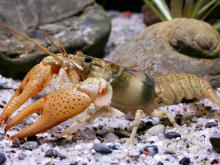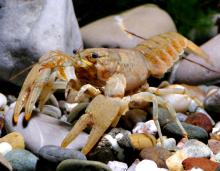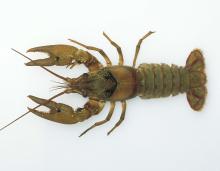Aquatic Invertebrates
Media

Species Types
Scientific Name
Faxonius ozarkae (formerly Orconectes ozarkae)
Description
The Ozark crayfish is light brown to reddish brown with numerous black specks on the pincers and often on the abdomen as well. The pincers are broad and powerful. It lives in the White and Black stream systems.
Media

Species Types
Scientific Name
Lacunicambarus ludovicianus (syn. Cambarus ludovicianus)
Description
The painted devil crayfish is a burrowing lowland species. In Missouri, it is known from only a few locations in the Bootheel. Its overall color is olive green to blue, with reddish and cream markings.
Media

Species Types
Scientific Name
Faxonius medius (formerly Orconectes medius)
Description
The saddleback crayfish has a bold blackish band across the hind margin of the carapace and lacks dark blotches or specks. The pincers are broad and powerful. It occurs in the Big and Meramec river drainages.
Media

Species Types
Scientific Name
Faxonius williamsi (formerly Orconectes williamsi)
Description
Williams' crayfish is small and rather plain, without bright colors or bold markings. It has a pale, vase-shaped zone along the middle of the dark olive-tan carapace. It is found only in the upper White River drainage of Missouri and Arkansas.
Media

Species Types
Scientific Name
About 38 species in Missouri
Description
Crayfish are freshwater aquatic invertebrates that look a lot like small lobsters, to which they are related. There are about 38 species of crayfish in Missouri.
See Also
About Aquatic Invertebrates in Missouri
Missouri's streams, lakes, and other aquatic habitats hold thousands of kinds of invertebrates — worms, freshwater mussels, snails, crayfish, insects, and other animals without backbones. These creatures are vital links in the aquatic food chain, and their presence and numbers tell us a lot about water quality.





















